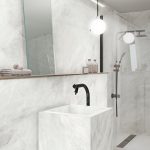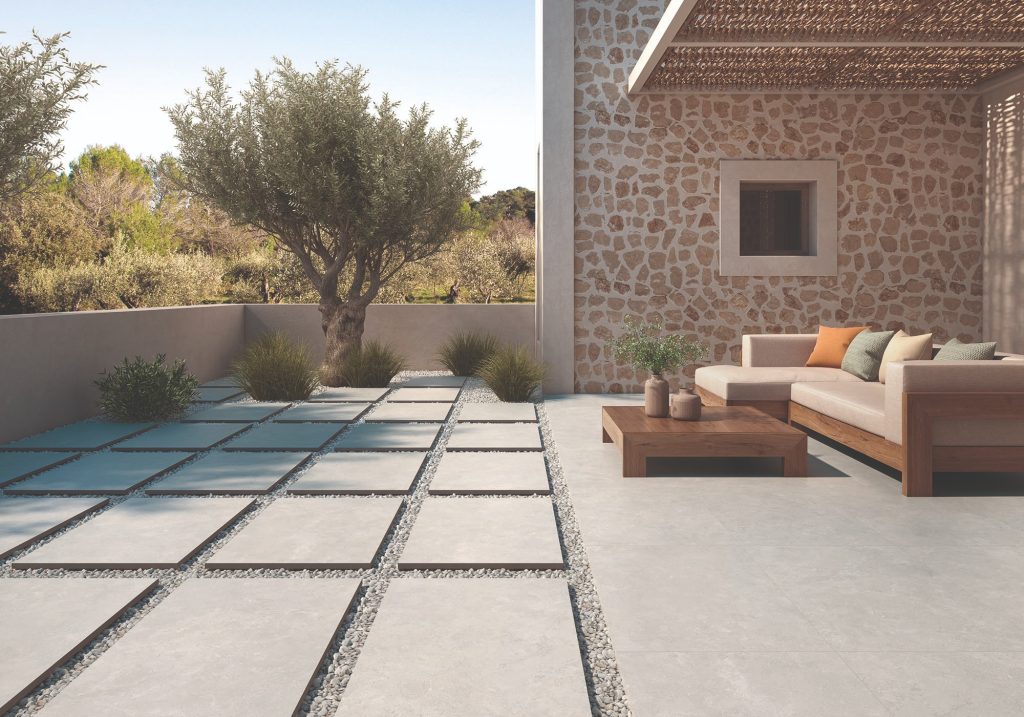Why Focus on Wall Tiles?
These are significant spaces as they define the overall ambiance and functionality of both kitchens and bathrooms. These are like backdrops for frequently used spaces and need to be combined with durability. Wall tiles add design versatility, durability, and easy maintenance to any space. There are lots of colors, patterns, textures, and finishes to suit design aesthetics from modern and minimalistic to traditional and cozy.
Coordination ideas for wall tiles with Kitchen Floor tiles
The coordination between kitchen tiles and wall tiles needs great attention, specifically because these tiles absorb a great amount of residue from cooking and do not look the same after the space has been used for a while. The wall tiles in the kitchen, therefore, need to be stain-resistant and can bear the residue. Along with the functionality, you also need to focus on color, pattern, and texture. The research explains that the selection of a harmonious palette rather than exact matching gives a modern touch. If your kitchen floor has a marble style or natural stone finish, then you can use simple single color wall tiles like dove grey or matte white to avoid creating design overload. According to experts from Tiledemand, pairing marble floors with subdued wall tiles creates an elegant look. Specialised literature of interior designing explains that for a professional look, you can combine glossy kitchen wall tiles with matte floor tiles, as it improves the sensory contrast and prevents the surfaces from looking overly reflective or monotonous. You can also incorporate subtle color toe-line like grout, matching the floor tiles.
Matching Bathroom Tiles with Kitchen Wall Tiles
Kitchen and bathroom tiles are different areas, but both of them are very personal spaces. Hence, wall tiles for the area also have great importance for many. To avoid clashing styles in your bathroom, you can use neutral or complementary undertones. For instance? Warm taupe bathroom tiles coordinate with beige wall tiles. You can also consider textural contrasts with glossy bathroom wall tiles that are paired beautifully when worked with kitchen textures. Another great tip is to match size proportions. It is best to use large bathroom tiles.
Colors and Finishes
Color has always played a role when working with wall tiles, and it is important to know about them as it create a clash. Soft neutral colors like ivory, beige, or pearl whites create a timeless space with grey hues and other tones. Experts from TileDemand recommend pairing grey kitchen floor tiles with light colored kitchen wall tiles for a clear, warm effect. An advanced quick tip is to take a picture of your space and work with colors with an AI tool. It gives you an idea of what looks best and also recommends new ways to complement wall tiles and floor tiles. Finishes, on the other hand, should contrast subtly with the matte floor tiles offer grip and durability, while glossy wall tiles are easier to clean and brighten up spaces. The approach addresses practical needs while enriching space dynamics.
Roles of Patterns and Shapes
Pattern coordination provides a personality to the wall tiles, like small-format metro tiles paired with large plain tiles on kitchen walls or floors. It creates a feature wall that prevents styles from clashing with a minimal outcome. You can keep experimenting with different designs. Use digital tools to experiment and look at what might look good together. Advanced design techniques avoid direct matching patterns in the bathroom and kitchen. In fact, it is best to use complementary patterns while maintaining interest, not chaos. You can work with different elevate the look of your kitchen or bathroom.
Unique Expert Insights
- Use the technique of proportionate installation. This means matching wall tiles between spaces is about the proportion of coverage. Extend kitchen wall tiles to the part of the bathroom or floor wall, and create intentional transitional zones.
- Create visible grout lines with the right color and width of lines that influence the perception of tile coordination. Use consistent and slight grout colors that make different tiles more aligned.
- Use lighting influence as it dramatically changes tile coloration and texture. Visit showrooms under different lighting for both kitchen wall tiles and bathroom tiles.
- You can also create a personal feature wall, giving a customized look to your room and adding more meaning to it.
Practical Tips
- Always take samples if you like a pattern or a tone.
- Think of immediate rooms and visualize how wall tiles transition.
- Glossy wall tiles in the bathroom resist more than matte finish.
- Search for a relevant image with the same structure as your layout.
- Keep experimenting with different colors and patterns.
Conclusion
Creating a unique wall tile can be tricky. Once you find the best blend for your space by balancing color, texture, pattern, and finish, you can get the best design. By focusing on complementary rather than identical matches, homeowners can achieve a cohesive and elegant kitchen or bathroom. You can also go through Tile Demand for the best tile options. Use the tips from experts to make your wall tiles stand out.









